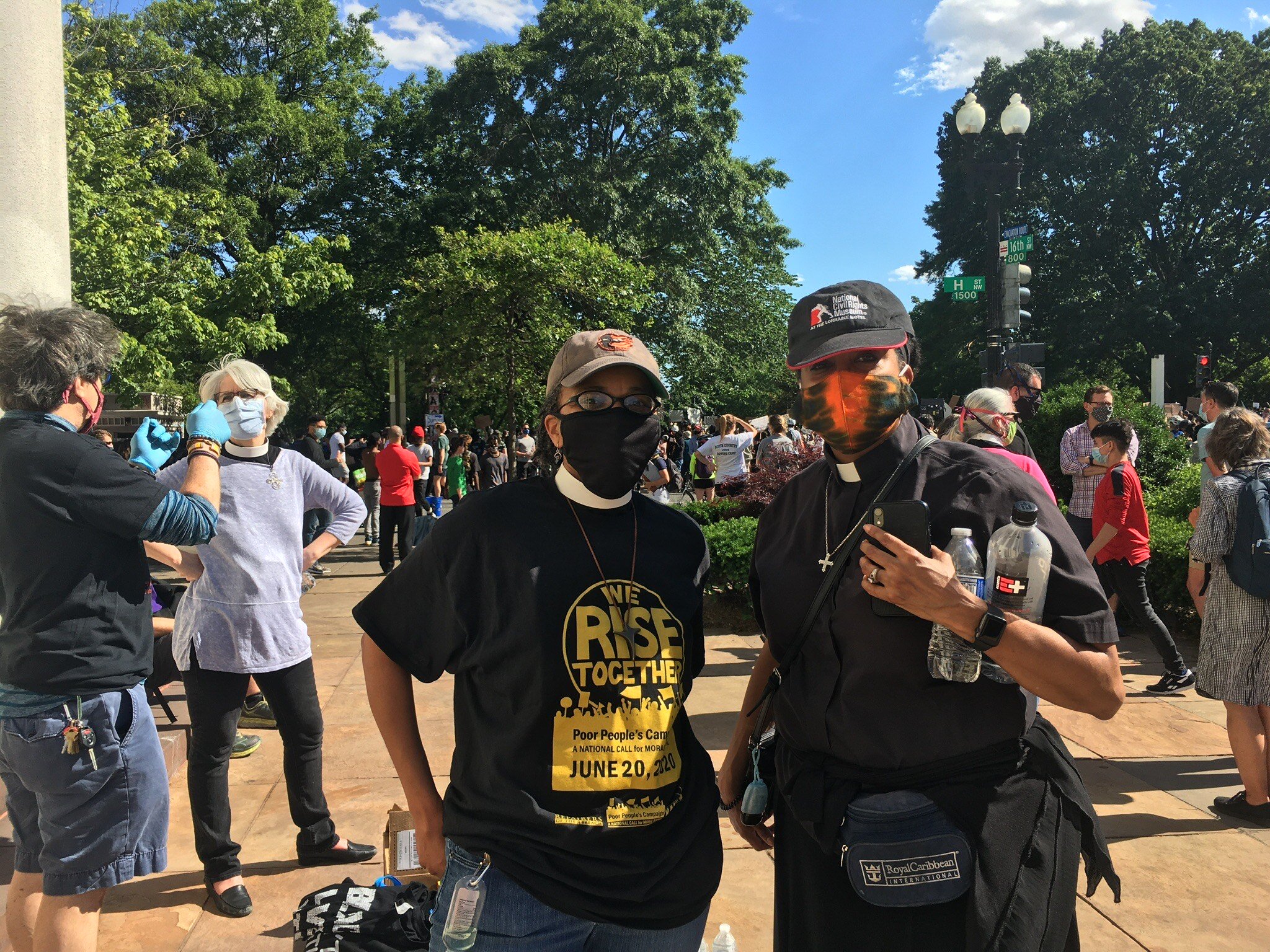IT’S NOT JUST ABOUT THE PHOTO OP
The author (l), with the Rev. Canon Paula Clark (r) outside of St. John’s Lafayette Square.
The last week of May has been a tumultuous experience. Of course, the discomfort has been just beneath the surface for months, if not years. In recent history, the Church of the Epiphany has grappled with the adverse impacts of a rapidly gentrifying city. Over the past 25 years, the church has been especially attuned to those experiencing homelessness and doing all that we can to treat everyone with respect and dignity. Over our 178 years in existence, we have stood with the marginalized and attended to their needs as best we are able. As the COVID virus spreads throughout the world and the district, we have again seen the disproportionate impact on black and brown people. As if the COVID crisis was not enough to fight, social media again helped highlight just how pervasive systemic racism is in this country. I watched in horror as Mr. Ahmaud Arbery was shot in the middle of the day while running, how a white woman used her whiteness in a way that could have been fatal to the black man who challenged her, and at the murders of Miss Breonna Taylor and Mr. George Floyd at the hands of police.
As the protests unfolded in the district, Epiphany continued to be present with those experiencing homelessness, and our proximity to the White House (2 blocks) makes our ministry even more poignant. On Saturday night, violence shifted the tenor of the protests and destruction to property changed the conversation; this was only amplified by the fire intentionally set at the historic St. John's Episcopal Church. And while we value the structure and all that it represents, we value even more the need for this country to grapple with the sin of White Supremacy and its fatal impact. And this is why I, as an African-American rector of an Episcopal church, a spouse, and parent, with a non-denomination-praying parent, went to St. John's Lafayette Square to offer hospitality to protesters who, in the midst of a pandemic and barely in phase one of reopening the city, were on the front lines to declare that Black Lives Matter. I have been to many protests and know that they can be peaceful, and they can change very quickly. On Monday, June 1st, as I was leaving with a clergy colleague, we knew that things were about to unravel in what had been, for many hours, a peaceful protest. It was a five-minute walk to our cars. I had traveled just to the outside of the perimeter that the district had set up and my mother called to inform me of what was happening at the White House. I pulled over to check on colleagues and friends and sent a text to those gathered at the church to be careful. I was angry to learn that the upheaval wasn't about protesters who had violated the norms, or a protester whose justifiable anger was no longer containable, but because the president wanted to take a photo in front of the church. I would have been angry about any one of these things but to learn that it was because the president wanted to take a photo was even more infuriating. I vented my anger on Facebook and it went viral (I've never been viral before!)
It's not just about the photo op.
I talked to a couple of reporters and tried not to get sidetracked from why we were protesting, why the church (the people, not the building) was present. And then one reporter asked me a couple of questions that gave me pause because I knew that I couldn't respond in a succinct sound bite. The reporter asked me how I felt about the Bible being used by the President in that way? Good question, and asking a person of color—a Christian, leading in a denomination that had, and has, a historically complicated relationship with race—how I feel about the use of the Bible requires a highly nuanced response.
He was holding up the same scriptures that had been used to support the very oppression that made it permissible to hold black humans as slaves. The same scriptures that had been used to justify the killing/lynching of those who defied their masters. But they are also the same scriptures that serve as a source of liberation for a people oppressed in all corners of the world. The same scriptures that helped shape the slave freedom narratives and music. The same scriptures that have provided hope and comfort to oppressed people when all hope appeared lost.
Holding those scriptures, the president was standing in front of a church that is a historical reflection of the Episcopal Church. The same denomination that relegated slaves to worship in separate spaces in the sanctuary. A denomination that profited from the African Slave Trade. And the same denomination that welcomed and ordained Absalom Jones in the 1700s and established the first black Episcopal church in Philadelphia. The same denomination that, in recent years, has begun earnest talks about reparations, drafted and implemented an anti-racism curriculum, and taken pilgrimages to intentionally address racism in our church and in our country. This Episcopal denomination that is making strides to recognize its history and do better.
So how does one feel about a person who has proven that he has no regard for black lives, standing in front of a church under the banner of a denomination that has a complicated and developing relationship with race, holding holy scriptures that have been used to both liberate and oppress, after violently dispersing a peaceful crowd drawing attention to systemic oppression and murder of black children of God? Yes, "outraged" is one word.
It's not just about the photo op.

